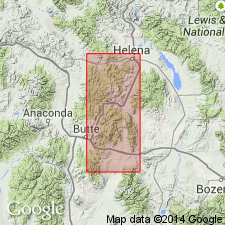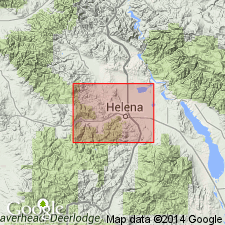
- Usage in publication:
-
- Unionville granodiorite
- Modifications:
-
- Named
- Dominant lithology:
-
- Granodiorite
- AAPG geologic province:
-
- Montana folded belt
Summary:
Name applied to a basic granodiorite body well exposed south and southeast of Helena, Lewis and Clark Co, MT in the Montana folded belt province. Named for town of Unionville south of Helena. No type locality designated. Chemical analyses given. Has a basic facies of hypersthene granogabbro, the name for an orthoclase-bearing variety of quartz gabbro. Mapped (geologic map) in one layer and two small bodies south of Helena. Resembles a diorite. Neither quartz nor potassium feldspar visible. Has 15 percent feldspar and quartz under the microscope. Is one of several intrusions related to the Boulder bathylith of Late Cretaceous age. Is older than the Clancy granodiorite (new) with which it is in contact. Is the earliest intrusion of the Boulder bathylith.
Source: GNU records (USGS DDS-6; Denver GNULEX).

- Usage in publication:
-
- Unionville Granodiorite*
- Modifications:
-
- Overview
- AAPG geologic province:
-
- Montana folded belt
Summary:
Considered to be the earliest major intrusive composed of augite-biotite-hornblende granodiorite with some hypersthene. Mapped as several large bodies in the southern part of the study area in Lewis and Clark Co, and in several small bodies along the Continental divide on the west edge of the study area in Lewis and Clark Co and in adjacent Powell Co, MT in the Montana folded belt province. Of Cretaceous age. Is older than the Clancy Granodiorite with which it is in contact.
Source: GNU records (USGS DDS-6; Denver GNULEX).
For more information, please contact Nancy Stamm, Geologic Names Committee Secretary.
Asterisk (*) indicates published by U.S. Geological Survey authors.
"No current usage" (†) implies that a name has been abandoned or has fallen into disuse. Former usage and, if known, replacement name given in parentheses ( ).
Slash (/) indicates name conflicts with nomenclatural guidelines (CSN, 1933; ACSN, 1961, 1970; NACSN, 1983, 2005, 2021). May be explained within brackets ([ ]).

